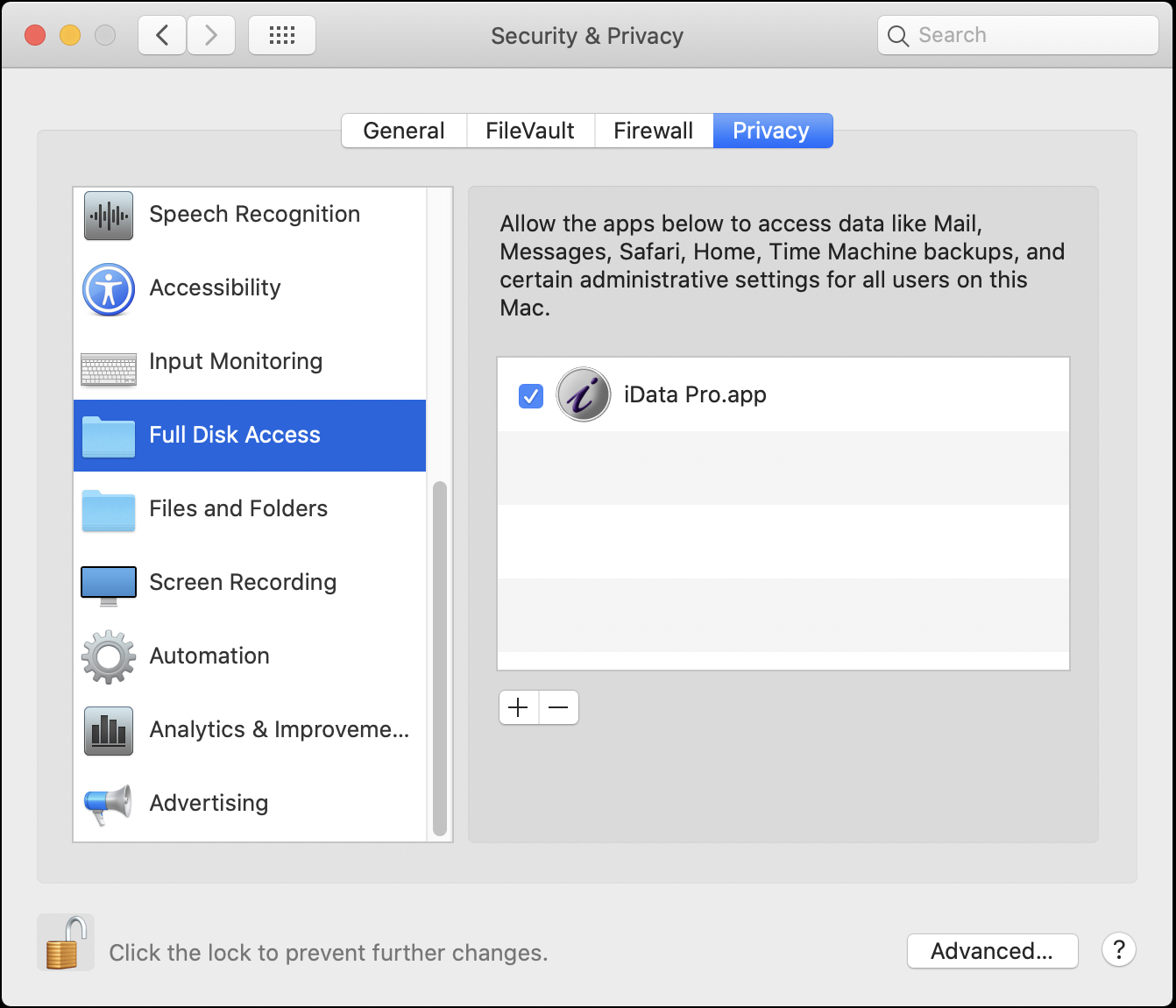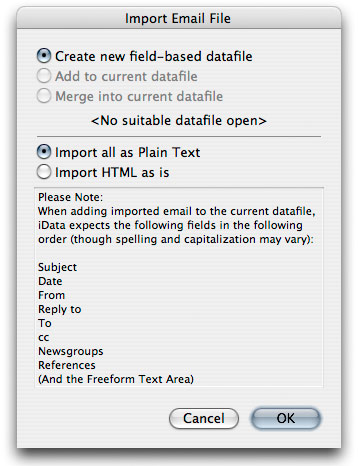Although iData Pro requires OS 10.10 or later, it is capable of importing Apple Mail folders going back to OS 10.4.
However, the way Apple Mail folders are stored changed after OS 10.6. To learn how to import Apple Mail files from OS 10.4 through 10.6, click here.To learn how to import Apple Mail files while running under OS 10.7 through 10.13, click here.
Importing Apple Mail Files Under OS 10.14 and Later
1. Open System Preferences. (Select System Preferences... under the Apple menu.
2. Click the Security & Privacy button.
3. In the Security & Privacy window, select the Privacy tab.
4. In the left-hand column, select Full Disk Access.
5. Click the padlock icon at the bottom of the screen, and enter your Mac password when requested.
6. Click the + button in the right-hand section.
7. In the Open dialog that comes up next, navigate to iData Pro.app (probably in the Applications folder), select it, and click the Open button.
8. At this point, the Security & Privacy window should look like this.

9. Click the padlock icon to prevent further changes, and close the window.
Now you can use iData Pro to import your Apple Mail mailboxes.
These mailboxes will have a .mbox file name extension. Apple stores different mailboxes in folders that have long alphanumeric names.
Importing a Mailbox Under OS 10.14 and Later
1. In iData Pro, select the Apple Mail - OS 10.4 or Later in the Import sub-menu, under the File menu.
2. The Open dialog will open the Mail folder, showing the V-folder.

3. Open the various folders that have the long alphanumeric names until you find the .mbox that you want to import. Then highlight it and click the Select button.
Other Mail Folder Locations
If you have created sub-mailboxes within other "root" mailboxes, you can open a root mailbox to import a sub-mailbox. The previous image is from my personal Mac. Here's what Chinese List.mbox looks like when it is opened:

If I select Chinese List.mbox, both the main-level folder emails and the Beijing Sounds.mbox will be imported. If I want only Beijing Sounds.mbox, I can just select that one.
Some of your messages may be in the
Inbox, especially if you haven't created folders
and Rules for directing all your email messages into folders,
The Inbox is in a slightly different place. In the same folder
as the Mailboxes (folder listed above), you will find a folder that
begins POP-
and includes your email address. In that folder will be an INBOX.mbox folder. This is where your Inbox
messages are located. The POP- folder will also
contain your Sent and Drafts folders.
Completing the Import Action
Once you have selected folder to import, click the Open button. A dialog will appear
giving you several options.

If a datafile with the exact field structure needed for email import is not open, the only option will be to create a new datafile. This is always the safest option. You can later adjust the field structure and merge datafiles if needed.
If you have a datafile open with the appropriate fields, you can add or merge the imported records into the existing datafile.
Add to current datafile
This will append the imported records to the current datafile. No attempt will be made to determine if a message already exists in the datafile. To avoid duplicate records, you must be sure that messages you previously imported are not in the folder that you are now importing.
Merge into current datafile
This will sort the current datafile and only import messages that are not already in the datafile. If there is the slightest difference, iData Pro will see it as a new message.
Email Record Structure
iData Pro places the message portion of each imported email message into the Freeform Text Area of a record. In addition, any existing data of the following types will be put into matching fields:
Subject
Date
From
Reply to
To
cc
File Name
References
Import Speed
Old HTML messages that contain links to images that no longer exist on the Web are a particular problem, as the system may spend as much as a minute (which feels like forever) trying to find the image before giving up. In a few cases, the system will not be able to process such a message, and will return an error code. In these cases, iData will place a message saying, "HTML could not be processed." in the Message area.
If you notice that you have a record containing an unprocessed message, you can look at the File Name field to find the name of the .emlx file. Find that file in the Finder and double-click it to open it in Mail. Then, you can copy the message content in Mail and paste it into the iData record.
If it seems that the import is going on for longer than normal, you can abort the import process at any time by typing the esc key or command-period. However, if you know that the mailbox being imported is large, it's probably best to be patient. When the process is aborted, messages that have already been imported will show up in the datafile.